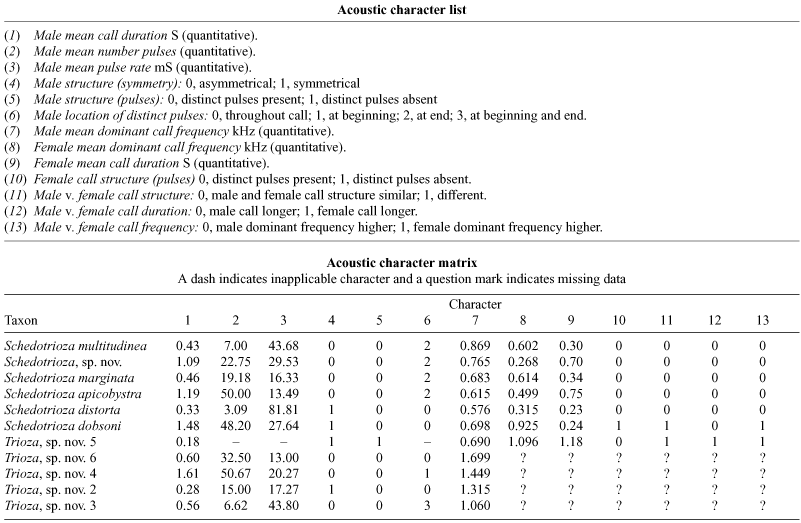Psyllid communication: acoustic diversity, mate recognition and phylogenetic signal
Diana M. Percy A E F , Gary S. Taylor B and Martyn Kennedy C DA CSIRO Entomology, GPO Box 1700, Canberra, ACT 2601, Australia.
B School of Agriculture and Wine, Waite Campus, University of Adelaide, SA 5005, Australia.
C Division of Environmental and Evolutionary Biology, Institute of Biomedical and Life Sciences, University of Glasgow, Glasgow G12 8QQ, UK.
D Current address: Department of Zoology, University of Otago, PO Box 56, Dunedin, New Zealand.
E Current address: Centre for Plant Research, University of British Columbia Botanical Garden, 6804 SW Marine Drive, Vancouver, British Columbia V6T 1Z4, Canada.
F Corresponding author. Email: dmpercy@interchange.ubc.ca
Invertebrate Systematics 20(4) 431-445 https://doi.org/10.1071/IS05057
Submitted: 4 December 2005 Accepted: 2 June 2006 Published: 29 August 2006
Abstract
Acoustic signals play an important role in mate selection and speciation in diverse groups of insects. We report reciprocal acoustic mate signalling, often as highly synchronised duetting, for several species of psyllid (Hemiptera : Psylloidea). We reveal that considerable acoustic diversity is present in Australian psyllids belonging to the family Triozidae. The acoustic signals are species and gender specific. Our acoustic analysis and observations suggest that acoustic signals are important in both species recognition and mate selection in psyllids. We found a significant level of phylogenetic signal in the acoustic data when we compared divergence in genetic data (obtained from mitochondrial DNA sequences of the small subunit rRNA) with divergence in acoustic signals in two groups of Australian psyllids. Phylogenetic reconstruction based on DNA sequence data supports the monophyly of the Eucalyptus-feeding genus Schedotrioza Tuthill & Taylor, 1955, whereas a diverse but little known group on Casuarinaceae hosts appears to be paraphyletic. These two psyllid groups also differ in amounts of geographical and ecological sympatry. We found a significant positive correlation between acoustic distance and genetic distance using pairwise comparisons for all taxa, but the trends within the two groups differ due to a negative association between acoustic and genetic divergence among the sympatric taxa. Phylogenetic information in acoustic data may be greatest in recently speciating and allopatric groups because of increased acoustic divergence in sympatric taxa and greater acoustic convergence in more distantly related species.
Additional keywords: acoustic communication, Allocasuarina, Casuarinaceae, Eucalyptus, Psylloidea, speciation, substrate vibration, Triozidae.
Acknowledgments
Funding was provided by the Leverhulme Trust (studentship award to D.P.). M.K. was supported by a New Zealand Foundation for Research, Science and Technology Postdoctoral Fellowship. The recording equipment was purchased with a grant from the Systematics Association (awarded to D.P.). We thank Chris Hardy (University of Glasgow) for the construction of the amplifier, and Rob Magrath (Australian National University) for assistance with Canary software. For comments on the manuscript we thank Quentin Cronk and three anonymous reviewers. We thank Chris Burwell, Pam Dale and David Hollis for supplying psyllid material for molecular analysis.
Bailey W. J.
(2003) Insect duets: underlying mechanisms and their evolution. Physiological Entomology 28, 157–174.
| Crossref | GoogleScholarGoogle Scholar |
[Verified 1 July 2004.].
Taylor G. S.
(1985) The taxonomic status of Schedotrioza multitudinea (Maskell) (Psylloidea: Triozidae) with notes on its biology. Journal of the Australian Entomological Society 24, 305–312.

Taylor G. S.
(1990) Revision of the genus Schedotrioza Tuthill & Taylor (Homoptera: Psylloidea: Triozidae). Invertebrate Taxonomy 4, 721–751.
| Crossref | GoogleScholarGoogle Scholar |

Taylor K. L.
(1962) The Australian genera Cardiaspina Crawford and Hyalinaspis Taylor (Homoptera: Psyllidae). Australian Journal of Zoology 10, 307–348.
| Crossref | GoogleScholarGoogle Scholar |

Taylor K. L.
(1985) A possible stridulatory organ in some Psyllloidea (Homoptera). Journal of the Australian Entomological Society 24, 77–80.

Tishechkin D. Yu.
(1989) Sound signalling of psyllids (Homoptera, Psyllinea) in the Moscow region. Moscow University Biological Sciences Bulletin 44, 20–24.

van Tets G. F.
(1965) A comparative study of some social communication patterns in the Pelecaniformes. Ornithological Monographs 2, 1–88.

von Dohlen C. D., Moran N. A.
(1995) Molecular phylogeny of the Homoptera: a paraphyletic taxon. Journal of Molecular Evolution 41, 211–223.
| PubMed |

White I. M., Hodkinson I. D.
(1985) Nymphal taxonomy and systematics of the Psylloidea (Homoptera). Bulletin of the British Museum (Natural History). Historical Series [Natural History] 50, 153–301.

Yang M. M.,
Yang C. T., Chao J. T.
(1986) Reproductive isolation and taxonomy of two Taiwanese Paurocephala species (Homoptera: Psylloidea). Monograph of Taiwan Museum 6, 177–203.

Yen A. L.
(2002) Short-range endemism and Australian Psylloidea (Insecta: Hemiptera) in the genera Glycaspis and Acizzia (Psyllidae). Invertebrate Systematics 16, 631–636.
| Crossref | GoogleScholarGoogle Scholar |


|

|



